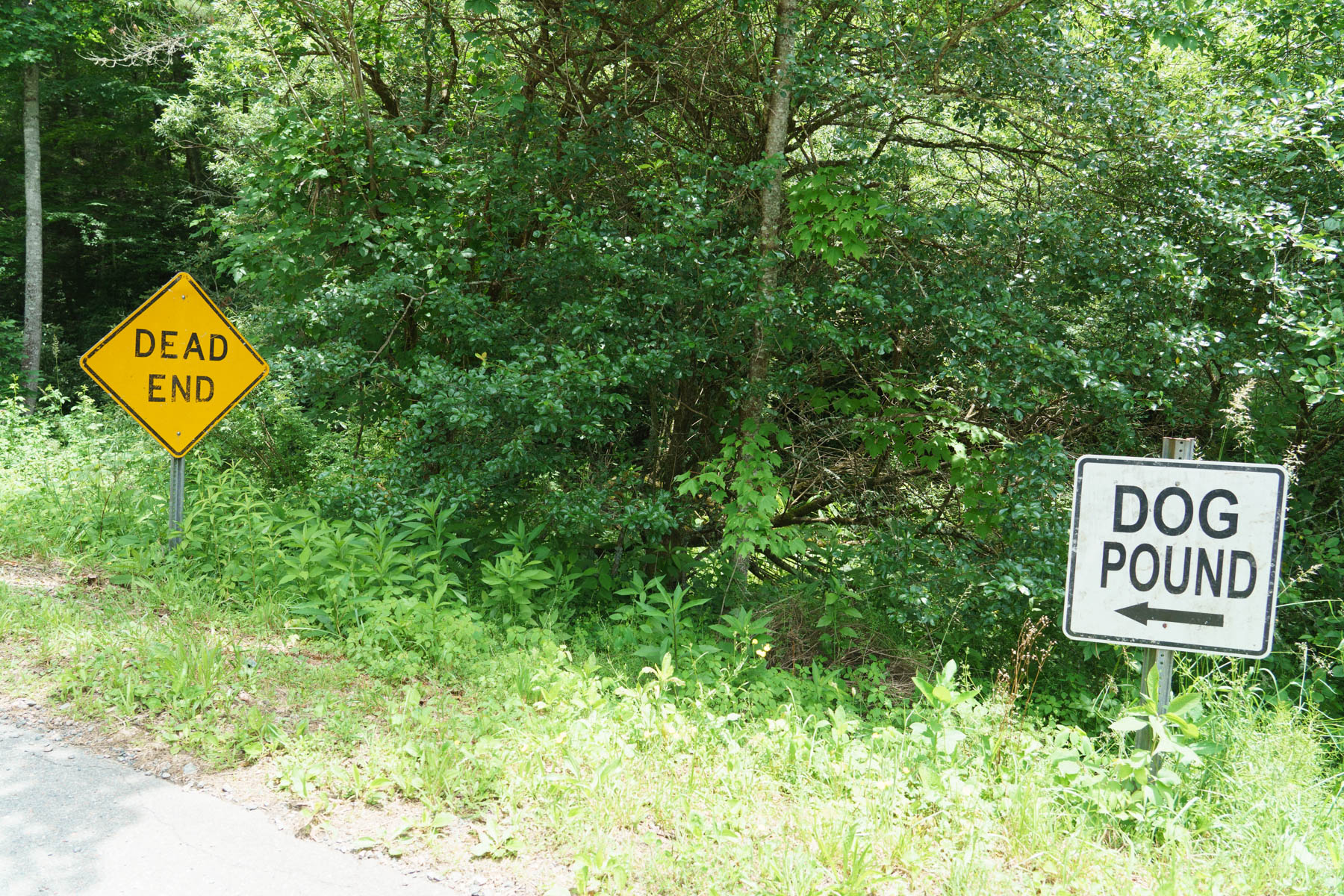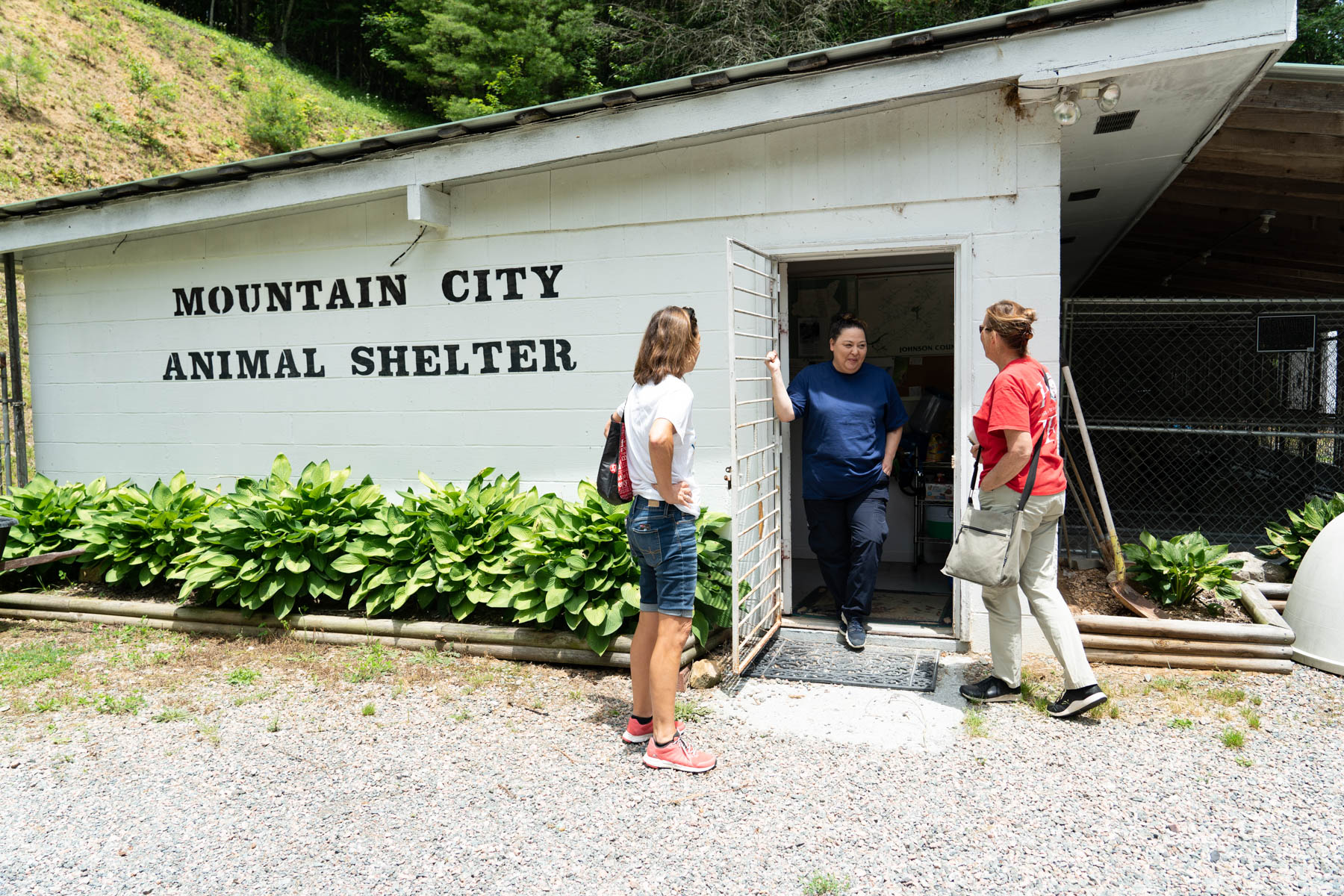It was a beautiful drive up to Mountain City, Tennessee. We followed a dead-end road up a hollow where it ended at the animal shelter. Mandy had told us to drive until the pavement ended and there would be the shelter. And there it was.


Mountain City Animal Shelter is a tiny cinderblock building nestled into a woody hillside. There are eight kennels with indoor/outdoor access separated by guillotine doors. The shelter handles about 500 animals a year (dogs and cats).
Mandy is the only employee. She works at the shelter 7 days a week, 365 days a year (her husband helps her out sometimes on the weekends). When she really needs a day off, someone from the street department (the shelter is technically under the street department) will cover for her.

She’s on call 24 hours and handles all the animal control calls for the city and the surrounding county. The county can rent four kennels from the shelter when they need them – mainly for bite holds and court cases, but Mandy handles the dogs and the paperwork.
The day we visited, there were only four dogs (plus Mandy’s dog who comes to work with her). The cat room had plenty of cats, though. (One really liked our board member, Karen, who was traveling with us.) The shelter mostly sees pit bulls and hounds. We met an extremely well-mannered and sweet pit bull mix, who Mandy picked up from a home where he was kept in a crate much too small for him and stood on a foot of feces. Two beautiful black and white dogs, plus Copper (found on Copper head road). Nancy took pictures of Copper for Mandy to use to network her to rescue. She was darling and we all enjoyed spending time with her.








Mandy began working at Mountain City seven years ago. Back then, she told us, the shelter had an 80% kill rate. In the last four years, Mandy has not had to euthanize a single dog, and only three cats (for medical reasons). She gets the dogs out through rescue and makes sure that all the dogs and cats leave spayed or neutered despite having only an $800 medical budget per year.
Her food budget is also $800/year. Anyone who has a pet knows that you’ll spend close to that on a single dog, let alone 500 animals. So, she depends on donations and help from the rescues, particularly Rescue DOG & End of Life Sanctuary, a local rescue that helps her out when she gets in a bind, especially with medical cases. We loaded her up with all we had left in our vehicle.

Mandy said that the number of animals she handles is slowly declining each year, mostly because she is working with people who want to surrender their pets to help them keep their animals.
When I checked in with Mandy to see how things are going since our visit in June, she told me that she’s gotten the shelter down to just one dog through working her rescue connections. Mandy needs to deal with some health issues, so emptying the shelter is critical, as she won’t be able to offer the care she normally does.
I asked Mandy what would help the animals in the city and county she serves, and she said, “Better dog laws.” This seems to be the case throughout the south. Most states that do not have shelters overflowing with animals are ones with strong dog laws about licensing, tethering, humane treatment, and spay/neuter. We all hope that people will naturally value their animals and treat them humanely, but for many, it takes strong laws to teach that value.
Like so many municipal shelters, we don’t encourage you to send money, but if you’d like to help supplement Mandy’s meager budget, she could use help with food and supplies through her Amazon wishlist, or people can send money to her account at the vet in Damascus, who does the shelter’s vet work at a reduced rate (Fisher Hollow Vet, 276-475-5397).
I can’t imagine doing Mandy’s job all alone up at the end of that peaceful hollow. Yet, she seemed to like her work and the animals in her care. She is quietly there, every day, working to care for the animals and improve the situation in this mountain town. I didn’t pry about the details of Mandy’s health issues, but it did make me wonder, as I often do, what if this incredible dog-hearted woman who is single-handedly saving every animal that lands in her shelter is no longer able to do it—what then?

Until each one has a home,
Cara
If you want to learn more, be sure to subscribe to this blog. And help us spread the word by sharing this post with others. If you live in Tennessee or know someone who does, be sure to share this story. Many people have no idea what sheltering looks like in their counties and states.
You can also help us raise awareness by following us on Facebook, Instagram, YouTube, and Tik Tok!

Learn more about what is happening in our southern shelters and rescues in the book, One Hundred Dogs & Counting: One Woman, Ten Thousand Miles, and a Journey Into the Heart of Shelters and Rescues (Pegasus Books, 2020). It’s the story of a challenging foster dog who inspired me to travel south to find out where all the dogs were coming from. It tells the story of how Who Will Let the Dogs Out began. Find it anywhere books are sold. A portion of the proceeds of every book sold go to help unwanted animals in the south.
Watch our 30 minute documentary about rescue in western Tennessee here.
For more information on any of our projects, to talk about rescue in your neck of the woods, or become a WWLDO volunteer, please email whowillletthedogsout@gmail.com or carasueachterberg@gmail.com.



Leave a Comment
Sign up for our newsletter
Sign up to have our latest news, grant updates, shelter visits, and more delivered to your inbox.
Share this:
Like this: